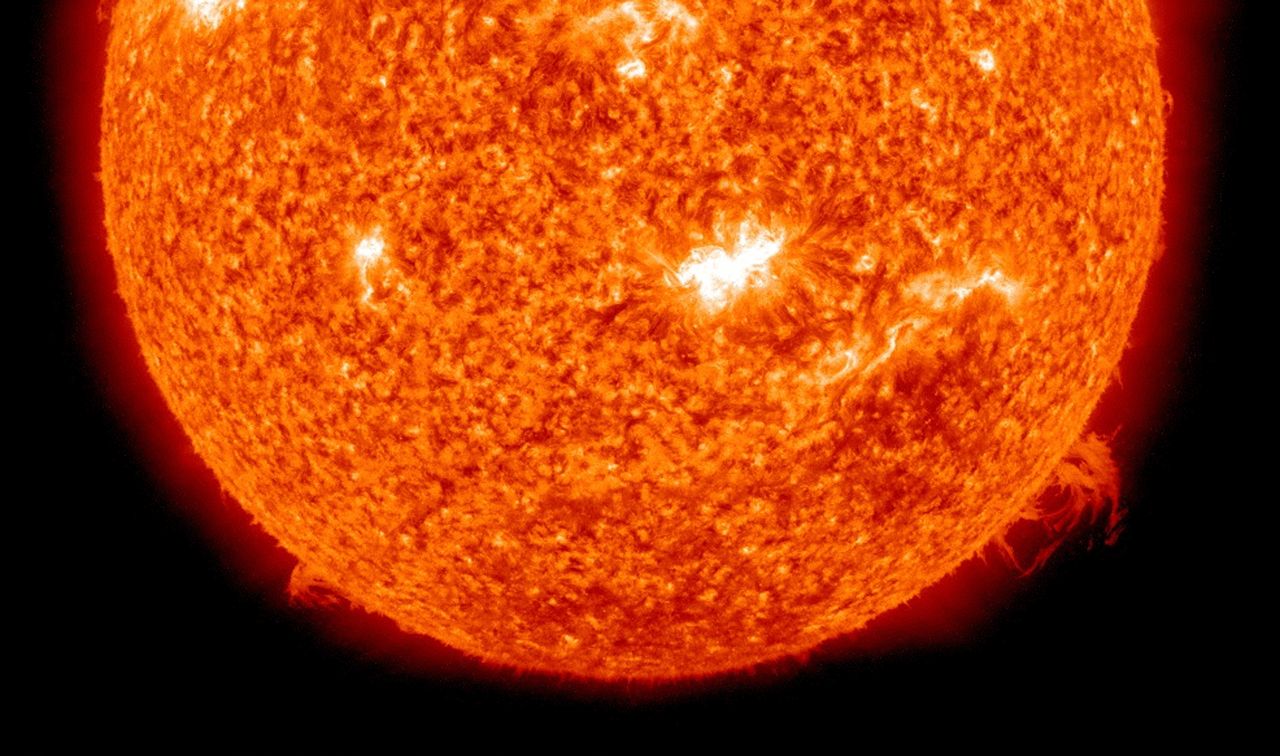
Imagine the worst thing that could happen to us and Earth. Perhaps you think of a global catastrophe, or pandemic diseases? Maybe it’s nuclear destruction, global wars or global warming? As an astronomer I have my own favourite hypothetical scenarios, with Earth facing cosmic dangers from the depth of space. Even though they might not all wipe us out, they will definitely cause us a great deal of harm and trouble.
Top of my list is a high energy solar flare. These events are high energy outbursts from our sun, sending vast amounts of radiation and particles into space and sometimes towards Earth. Our sun seems peaceful and harmless to us on a daily basis. However, if you observe the Sun safely you can see the churning surface and sunspots, many times larger than Earth itself, created by a huge magnetic field. You would also notice on a daily basis how the Sun throws material out into space.
Powerful as these events are, our Earth has a protective magnetic field of its own, shielding us from the worst of the effects. As a beautiful side effect it also leads to some particles entering the high atmosphere at the poles and causing northern or southern lights. But these common outbursts are dwarfed by rare high energy flares. We have previously documented the impact of only one of these - known as the Carrington event - in the very early development of our electrical technology in 1839. It caused havoc with electrical equipment, damaged telegraph systems and caused electrical shocks to operators of telegraphs.
If this was to occur in our modern society, which heavily relies upon electronics, telecommunications and satellites, the impacts would be severe. A much smaller event, known as the Halloween storms of 2003, gave us a small insight as to what a larger event would look like; with local blackouts, space station personnel asked to seek shelter and high latitude flights being rerouted due to high radiation levels. Overall, a Carrington event would not wipe out humanity but there would be no electricity, heating, air conditioning, GPS or internet, plus food and medicines would go bad. As a modern responsible society we need to be aware of the dangers such events pose. As such, scientists have created a report on what such severe space weather would mean for society.
Moving on, asteroids are probably the most common example of death from space. They are also significantly more notorious; most likely a result of Hollywood films such as Armageddon and Deep Impact and literature. The dangers of asteroid impact and the need to protect us from these ticking time bombs is being promoted by annual events such as Asteroid Day.
There are a huge amount of space rocks out there in space but the bigger they are the rarer they become and luckily, only the really big ones would cause global destruction. Still, we need to be aware of this danger, monitor hazardous asteroids and develop a way to possibly divert the ones on collision course. DART is a NASA mission now in the preliminary design phase that will redirect a small asteroid moon around Didymos by simply hitting it - a first step to protect Earth.
If you think these are the only things threatening us on Earth, think again. Space is vast and harbours more possibilities. Nearby supernova could be a danger, but they would have to be closer than 50 light years. And as far we know there isn’t a candidate that fits the bill around.
Local gamma ray bursts are more energetic outbursts from supernova or binary stars. They can concentrate their energy into a narrow beam and damage our Ozone layer. We cannot predict when this would happen and if the direction of the beam would even hit us but we know that it could be possible.
Or, risk could simply come from another star wandering on its path around the Milky Way too close to our sun. It does not need to strike us or the Sun, just nudge a few comets from our Oort cloud so they then hurtle to the interior solar system, increasing the chances of us being struck by a comet. And of course there are even more exotic and rarer scenarios.
Before we now think of imminent doom and crawling under a table, here are my final words on all of this: These are cosmic dangers that are either impossible to prevent or very challenging at the least. More likely are human made disasters. All this shows us that we live on a planet and in an environment that is very special and deserves our every effort to look after it. It is overall just a pale blue dot, a blue marble in the depth of a cold and hostile universe.
But as always, where there is danger there is hope and beauty. Without the rays and energy of our sun, life on Earth would be impossible. Without asteroids striking Earth we might not have received the amount of water needed to form life and we definitely would not have seen the timely demise of the dinosaurs. So rather than looking into the night sky and wondering what will kill us next, we should marvel at the depth of space, the wonders therein and the sublime nature of the universe. Be inspired by space. It offers future and meaning.
HuffPost UK Tech has launched HuffPost-Apocalypse, a project that aims to investigate what an apocalypse would mean for humanity, how we can best delay the end of the world, what the world will look like after we’re gone and what the best viable options for survival will be for anyone left. Join in the conversation with #HuffPostApocalypse on Twitter. To read more from the series, visit our dedicated page.
